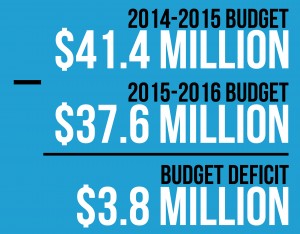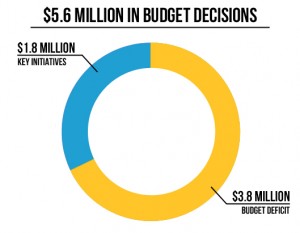Lower 2015-2016 budget a result of estimated lower enrollment numbers

Like numerous colleges around the country, Concordia faces challenges in preparing its budget for the 2015-2016 fiscal year.
Concordia faces $5.6 million in decisions for the upcoming fiscal year that runs from May 1, 2015 to April 30, 2016. This number is the result of a $3.8 million budget shortfall combined with an additional $1.8 million to fund key strategic initiatives.
The challenge in front of us is a challenge we foresaw, President Craft said in a faculty and staff budget meeting on Monday morning. It is a challenge that is being faced across the country, he added, especially in the upper Midwest.
The $3.8 million budget decrease results from an estimated drop in net tuition revenue, which is determined after financial aid has been subtracted from gross tuition revenue. The estimated net tuition revenue for the 2015-2016 fiscal year is $37.6 million, a decrease from the targeted $41.4 million net tuition revenue during the 2014-2015 fiscal year.

A continued decline in enrollment has led to the decrease in tuition revenue.
“We’re tuition-dependent, which means we’re enrollment-dependent,” said Vice President for Finance, Linda Brown, “so when you have swings in enrollment, they make a big difference.”
The presumed enrollment for the 2015-2016 academic year is 2,289 students, which is almost 100 students less than the 2014-2015 academic year. This number, Craft said, is the combined result of a lower number of recruits for the fall and a higher anticipated number of graduates in May 2015. As of last Thursday, Jan. 29, the total number of applicants was 2,054; the total number of admitted students was 1,532; and the total number of net deposits was 323, Brown confirmed.
The number of Minnesota high school graduates is at a 10-year low, according to the Western Interstate Commission for Higher Education. This implies a reduction in the number of degree-seeking students, Craft said, and has serious implications for Concordia because a significant majority of Concordia students come from Minnesota.
“It would be unwise to assume that we can recruit the same number of students (to the) college every year that we did a decade ago,” he said.
Concordia must prepare for an average student body between 2,300 and 2,500 students, Craft said, compared to the recent past average of 2,700 students.
To address the coming fiscal year’s revenue loss, Concordia is taking a number of actions. These actions include increasing the Annual Fund goal from years past, generating new revenues, achieving operational savings, reorganizing college administration for more efficient practices and reducing the number of faculty and staff to reflect the size of the student body.
“The whole idea here is to have as much of our resources aimed directly at the central business of the institution which is teaching and learning,” Craft said.
Concordia is also looking to reallocate funds for key strategic initiatives, which include an increase in compensation for faculty and staff and various programmatic initiatives, such as ensuring integrative learning and career readiness for every Concordia student and debt service for the future science facility.
Brown explained the college needs to recruit great faculty and staff and provide them with resources to do the highest priority work for the students.
Unit budget managers, such as academic department chairs and program directors and administrative directors who monitor and define budgets, are expected to submit budget requests for the 2015-2016 fiscal year by Feb. 20. Dean of Academic Affairs Eric Eliason has sent out a request for proposals sent to him to come in 12 percent below the 2014-2015 level and to include a statement of what current practices will have to be eliminated. Budget requests will be submitted to the president’s cabinet, which will formulate a proposal that will be submitted to the Board of Regents in May.
“We will endeavor to make all short-term decisions with the long-term in mind,” Craft said. “The long-term being the flourishing of Concordia College, its mission and its students.”
